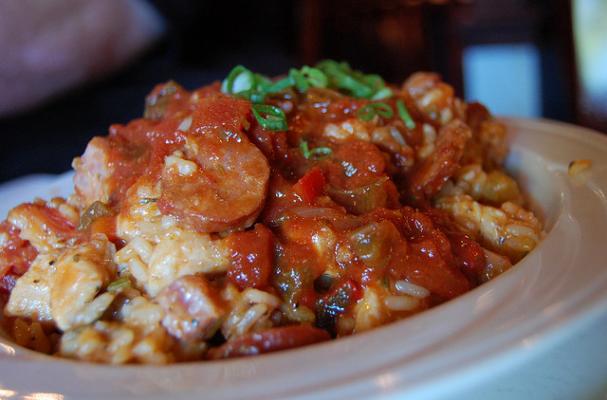A dish with French and Spanish origins, jambalaya is basically a meat usually consisting of ham (“jambo”, French), smoked sausage and/or chicken, with (“ala”, French “in the style of”) rice (“ya”, West African language). There are 3 distinct varieties of Jambalaya; creole, cajun and white. The creole style tends to be less spicy with more tomato, whereas Cajun (slang for “Acadian”) tends to be more spicy – an influence carried over from the early days of French settlers from the Acadia region of Canada migrating into the tropical regions of Charlestown, South Carolina, and the swamps of southern Louisiana.
The original Cajun food was peasant food consisting of crawfish, wild game, and any other source of nutrition available in the swampy environment. The various spices that were abundant in the area, were applied to cover up the spoilage taste and smell of these “swamp” foods. With the port of New Orleans becoming a major port city of North America, Cajun cuisine has evolved into an international delicacy.
Creole refers to the French of the West Indies migrating into Spanish influenced southern Louisiana. Creole food similar to Cajun though it tends to be less spicy with a more prominent essence of tomato.
The white variety is generally considered the “quick” method, where the rice is prepared separately with the meat and vegetable mixture served on top.
This is the method prescribed by Brennan’s of New Orleans.
Creole Jambalaya

Ingredients
- 1 tablespoon unsalted butter (or 2 tablespoons if pork and sausage are very lean)
- 4 ounces Andouille sausage*, sliced into ¼-inch rounds
- 4 ounces pickled pork** or ham, cut into ¼ cubes
- 1 medium yellow onion, chopped
- 1 bunch green onions, chopped, white and green parts separated
- 1 medium green sweet pepper, chopped
- 2 cans (10 oz size) crushed plum tomatoes
- ¼ cup canned tomato puree
- 2 cloves garlic, minced
- 1 whole bay leaf
- 1 teaspoon table salt
- ½ teaspoon ground black pepper
- ¼ teaspoon ground cayenne
- ¼ teaspoon dry thyme leaves
- 4 quarts chicken stock
- 1 tablespoon Louisiana pepper sauce
- 2 cups long-grain white rice, uncooked
- 1 pound raw medium shrimp, peeled
* smoked or Polish sausage (kielbasa) can be substituted for Andouille
** pickled pork…any good-quality ham may be used instead
Directions
-
Over medium-high heat, melt the butter in a heavy, non-reactive 6-quart saucepan or Dutch oven.
-
Add the sausage and pickled pork or ham and cook until all of the fat is rendered out of the meats, about five minutes stirring occasionally.
-
Add the yellow onions, the white part of the green onions and the sweet peppers, Cook the vegetables until they are clear, about five minutes, occasionally stirring and scraping the pan bottom clean.
-
Add the crushed tomatoes, tomato puree, garlic, bay leaf, table salt, black pepper, cayenne, and thyme. Cook and stir this base sauce about two minutes. (If the dish is being prepared ahead, allow the base sauce to cool, then place in a lidded non-reactive container and store in the refrigerator for up to two days. For the final preparation heat the base to a boil and proceed with the remainder of the recipe.)
-
Add the chicken stock and pepper sauce to the base and bring to a boil.
-
Reduce the heat to maintain a strong simmer, and simmer the liquid uncovered until it is reduced by one third, about one hour 15 minutes. Skim and foam or coagulates as they develop on the surface.
-
Return the liquid to a boil and stir in the rice.
-
Reduce the heat to medium and cook uncovered until the rice is just short of being done (it should still look a little firm in the center), about 25 minutes, stirring occasionally.
-
Add the shrimp and cook until the rice is tender and the shrimp turn bright pink, about three minutes. Do not overcook.
-
Stir in the green part of the green onions.
Notes for Making Ahead:
This recipe can be prepared up to two days ahead by completing steps 1 through 4, allowing the base sauce to cool a bit, then covering and storing it in the refrigerator. When it’s time to finish the preparation, bring the base sauce to a boil and proceed to step 5.
0 comments on “Creole Jambalaya” Add yours →